The Best Places to Live in Montenegro: Top 12 Cities for a Comfortable Life

When choosing a place to live many factors come into play: nature, climate, comfort, infrastructure, ease of legalization, transportation, visa-free entry, and more. You may have already recognized the overall advantages of Montenegro. But where exactly should you go and where should you live in this country? In this article, we will discuss the 12 best places to live in Montenegro.
Contents
How were the cities chosen for the article
The Best cities to live in Montenegro
1. Budva
2. Podgorica
3. Bar
4. Tivat
5. Cotor
6. Herceg Novi
7. Cetinje
8. Sutomore
9. Niksic
10. Zabljak
11. Petrovac
12. Ulcinj
The Cities of Montenegro on the Map
There are megacity countries with high-rise buildings that are overcrowded, modern, and bustling. And then there are other kinds of countries: cozy, small, convenient, and beautiful, like a beloved summer cottage. Even though it is small, it is surrounded by blooming trees, the house smells of wood, lavender, and pies, friendly and responsive neighbors that live nearby, and in the morning you can drink a coffee with a seaside view. This is the best description of warm, cozy, tiny, but stunning Montenegro. If you're tired of the hustle and bustle of megacities and large countries and are looking for a place on the map where you can leisurely enjoy each day, this country is an excellent choice.
When choosing where to live here, most relocators often prefer Budva, Podgorica, and Bar. Why is that?
- Budva is a resort town with a well-developed transport infrastructure, a bustling and crowded city at any time of the year. The historical part is closely intertwined with the modern part, offering everything a city dweller is used to — supermarkets, shopping centers, and high-rises.
- Bar is the only true city on the Montenegrin coast (built with urban planning rather than growing as a resort) with wide streets and boulevards and three huge temples of different denominations. In summer, Bar is filled with tourists and in winter it is a calm, green city under the huge snowy Rumija mountain — a paradise for those of us who are introverted.
- Podgorica is the capital of the country and that says it all. There are quite a few high-rises (over 5 floors), and recently, many modern new buildings and entire neighborhoods have sprung up. The capital boasts many parks and squares, which create excellent infrastructure. Also, if you want to go to the sea, you can get there in just over an hour.
However, the list of comfortable cities to live in is not limited to Budva, Podgorica and Bar. It's crucial to understand what exactly you want and what factors will be decisive for you when choosing where to relocate. Unfortunately, not everyone can afford to spend a month or two traveling around the country to evaluate the possibilities and convenience of each settlement. Moreover, as they say, "Do not confuse tourism with emigration." We hope this overview will help you decide on your future place of residence.
How Were the Cities Chosen for the Article
Before creating our selection, we thoroughly studied reviews from tourists, relocators, and locals about living in various towns and cities. We evaluated the characteristics of each location and chose the most convenient, safe, cozy, and beautiful cities in Montenegro to live in. After all, a place where you plan to stay, whether for a period of time or permanently, should be beautiful.
Additionally, we aimed to cover locations suitable for different types of travelers, varying in spirit, nature, climate, pace of life, and other factors. We hope that our list will help anyone dreaming of living in this country find a place they love. To make it easier for you to navigate, we've compiled a table highlighting the main advantages and disadvantages of living in each location from our selection.
The Best Cities to Live in Montenegro
The mild climate, warm winters even in the mountains, stunning nature, rich history, and, of course, the sea — these are what attract those who decide to move to Montenegro. Which city is the best to live in? The most important factors are living conditions, convenience, an accessible environment, and the usual amenities of civilization: stores, cellular service, public transportation, and internet.
Almost all the towns in the country are quite compact — there are no urban megacities covered in concrete and glass here. Yet, most of them are comfortable to live in, to varying degrees. Naturally, each town has its own unique features. Let's take a look at them.
1. Budva
Budva Municipality is the main tourist center of Montenegro.
Many expats when deciding where to live in this southeastern European country choose Budva. The town is quite compact —as of 2024, around 11,000 people live here permanently, so there are no overcrowded streets, congestion or traffic jams. Well, at least from October to the end of spring.
The climate in Budva and along the surrounding Budva Riviera is Mediterranean. In winter, it ranges around 10-13°C, and in summer the temperature doesn't go above 30-32°C. Budva is perfect for those who don't like big cities, love the sea and don't want to be far from the conveniences of civilization.
Infrastructure
The city, located on the Adriatic coast, is divided into two parts — the modern and the old. The old part features historical buildings and hosts cultural events, while the modern part boasts better infrastructure. However, don't expect to find 24-hour supermarkets like in big cities; there aren't any. There aren't many boutiques either, but there's plenty of greenery and fresh fruit.
Public transportation in the country isn't great. In the relatively large Budva, there are only two bus lines, with additional two in the summer season. Buses run regularly between towns, departing from the station every half hour to an hour.
Healthcare here is quite good. Budva has a polyclinic and many private clinics, including a branch of Milmedika, a hospital specializing in children's care. So, Budva is great for families, including those with young children.
Special Features
Foreign children can attend public kindergartens and schools, and students can enroll in the local university or college.
The job market, compared to Podgorica, is small, with most vacancies being seasonal and often filled by locals. Therefore, it's essential to resolve work issues in advance — either through remote work or starting your own business.
Advantages
The main advantages of Budva include:
- Clean drinking water and natural products.
- It's safe here — the crime rate is very low.
- Many English-speaking residents.
- There are more than three dozen beaches in the Budva area to suit every taste.
If you don't like swimming within the resort town, you can head to Becici. By the way, all locations on the Budva Riviera are practically nearby; you can even walk to some of them in a relatively short time.
Disadvantages
- The main problem for expats is the lack of jobs on the coast.
- Budva is a resort, so prices here are higher than the average in the whole country, including for real estate and groceries.
- In summer, the town is flooded with tourists, making living in Budva less comfortable, especially due to traffic jams.
- During the peak season, the beaches are far from clean and well-maintained.
- In Budva, you should also be prepared for lower quality mobile service and relatively slow and expensive internet.
2. Podgorica
The business capital and largest city of the country.
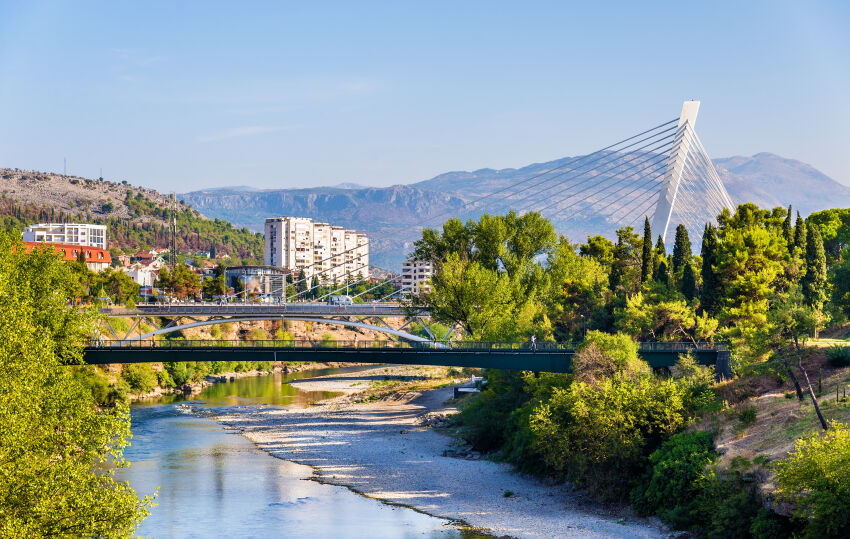
The capital attracts those who are used to the comforts of big cities. No, you won’t find concrete jungles here: Podgorica is small, has excellent transport accessibility, and is very modern, cozy, and truly European. And if you miss the beaches, mountains, attractions and natural beauty, they are all just an hour or two away.
Infrastructure
Podgorica has well-developed infrastructure, with shopping centers, supermarkets, kindergartens, schools and universities — far more than in other towns in the country.
Public transport here is fantastic, with many routes and new ones constantly being added. There’s even a taxi service where the entire fleet is made up of Teslas!
Special Features
Podgorica is constantly developing, with new schools and universities opening and a vibrant cultural scene. Despite not being a resort town, its cultural life attracts many tourists. There are always exhibitions and festivals happening, and the city has two theaters and a philharmonic.
Another unique aspect of the capital is the lack of seasonality, unlike the coastal towns. This means the rhythm of life remains the same throughout the year.
Advantages
Despite not being a resort, Podgorica is a very green city. In fact, it ranks fifth among the most green European capitals. The local authorities are continuously opening new green spaces.
The city has many shops, from small neighborhood stores to large supermarkets, all within walking distance. For example, you don’t need to travel to another district to buy building materials.
Additionally, in most towns from the country it’s hard to find a bank that is open after lunch. In Podgorica, banks and some other establishments are open until 8 PM, so you can get things done after work.
Another important point is the high-quality, stable and fast internet connection.
Disadvantages
Charming Podgorica, like any other city, does have its drawbacks.
- The architecture in the old Yugoslav quarters is quite dull, though low-rise. However, the new neighborhoods are much more visually pleasing.
- There are many cars and a severe lack of parking spaces.
- And, of course, the traditional "polako" (slow pace, lethargy) mentality is present even in the capital. No one is in a hurry here. Indeed, why rush? Life should be savored slowly, especially in Montenegro, often called the "showcase of paradise." However, this might be unusual for newcomers.
3. Bar
As a green, modern and yet cozy port city, it could easily be named as the best place to live in Montenegro.
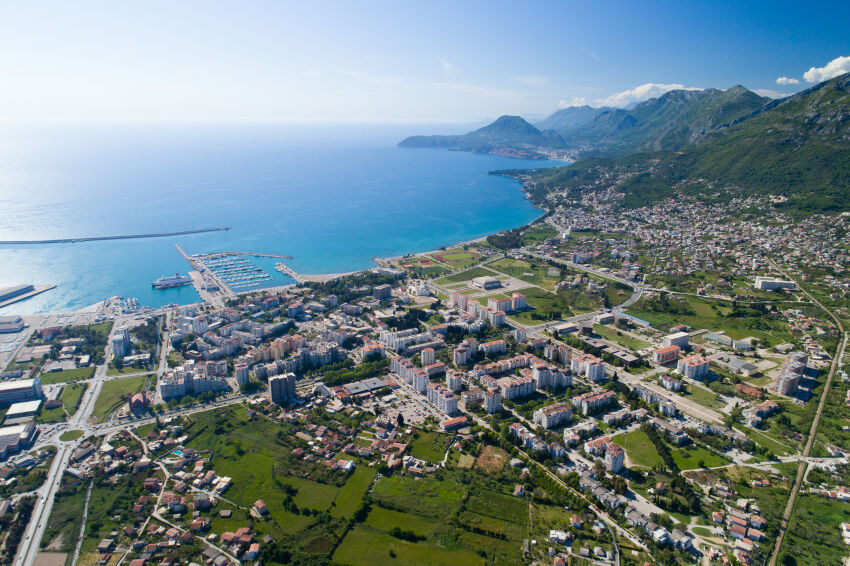
Bar is the center of the Bar Riviera, a relatively large port city on the Adriatic coast with a population of about 15,000 people. It boasts well-developed infrastructure and good economic potential, while also being green and cozy. The historical part of the town is impressive too, featuring an ancient fortress.
The pace of life in Bar is faster than in neighboring areas, and there are more opportunities. People choose Bar for relocation because they don't want to give up the comforts of civilization, want to live close to the sea, but are not ready for the higher prices in Budva.
Infrastructure
Bar has excellent infrastructure. It has everything a resident of a larger settlement would expect: supermarkets and a hypermarket, an excellent market with local produce, sports facilities right by the sea, schools, and kindergartens.
There are many medical clinics, a comfortable and large hospital in Old Bar, a bus and train station. You can get from Bar to Belgrade overnight (a ticket costs 30 euros), and to the capital Podgorica in just an hour, with a ticket costing 1.5 euros. Many students and schoolchildren commute daily from Bar to Podgorica for their studies.
The city has good roads and a decent amount of public transportation. Moreover, Bar is continuously developing: there's active construction, restoration, and expansion of the infrastructure.
Special Features
Despite its location, Bar is not exactly a resort, so there’s less focus on tourist infrastructure compared to Budva. There are fewer seasonal cafes and entertainment venues, the beaches are not very comfortable, and are mostly pebbly.
Advantages
There are many reasons to move to Bar. Besides the well-developed infrastructure, they include:
- Convenient location for driving in all directions.
- Proximity to the sea.
- Developing infrastructure: many shops, clinics, a large hospital with specialists (no need to go to the capital for appointments), good roads, etc.
- Relatively low prices compared to Budva.
- Excellent internet speeds — up to 400 Mbps. Working remotely from Bar is a true pleasure.
Disadvantages
Living here also has its downsides:
- The first is typical for the country — lack of central heating. In winter, it can get quite chilly, so you need to heat your home with air conditioners or heaters, which can be expensive.
- The climate doesn't suit everyone. In the winter months, there are strong winds and frequent rains. This is not only unpleasant but also leads to power outages. Fortunately, everything is repaired very quickly.
- Unkempt beaches out of season. This disadvantage is a result of Bar not being a resort town. However, the Bar Riviera stretches for 40 km, and there are plenty of clean, wonderful beaches in the surrounding area.
4. Tivat
Modern and comfortable Tivat is located on the Vrmac peninsula.
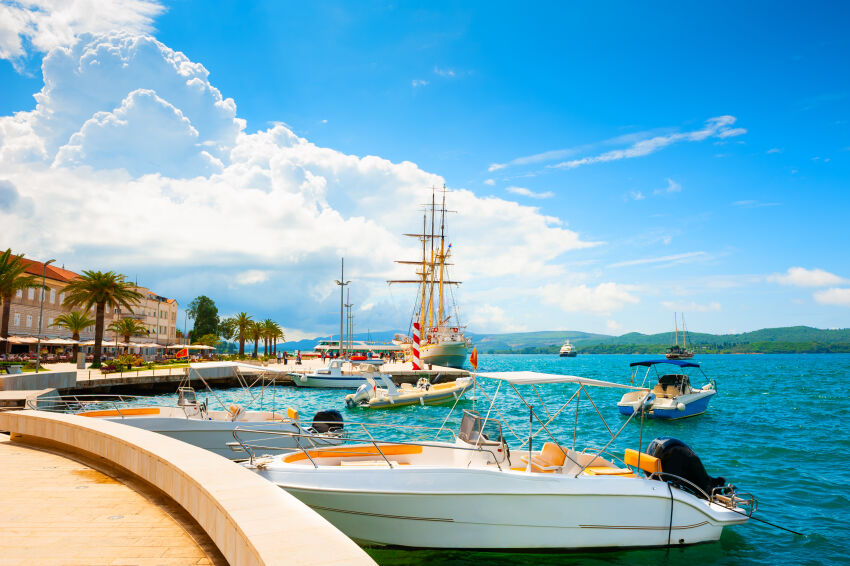
Tivat is situated on the bay's shore. Thanks to its Mediterranean climate, the summers are warm, and the winters aren't too cold. It's a place for those seeking a peaceful and relaxed lifestyle in the Coastal region of the country.
Unlike Budva, Tivat doesn't experience a tourist influx, yet it matches other coastal towns in comfort. The main attractions are its large marina and luxurious waterfront.
Infrastructure
Tivat's infrastructure is quite developed: there are places for entertainment, education, healthcare, and shopping for food and clothes. There are kindergartens, schools, and a post office.
Porto Montenegro, located near the center, is more than just a marina; it's essentially a separate district, luxurious and very expensive, with boutiques and five-star hotels. Prices in the boutiques of Porto are higher than in neighboring Italy, sometimes by a significant margin.
Special Features
The key feature of Tivat is its airport, located just 4 kilometers from the center, right on the seashore.
Advantages
- In the summer, Tivat blooms with abundant greenery.
- There are few tourists; most stay in other coastal towns.
- Prices are lower than in Budva and its surroundings, including rental costs.
- The waterfront is perfect for leisurely strolls.
- The stunning Porto Montenegro, with its accessible infrastructure.
Another advantage is Tivat's size. With only about 10,000 residents, it's a very compact town. This means you'll always be within walking distance of everything: beaches, bus stops, Porto Montenegro.
Disadvantages
In winter, life here slows down, many establishments close, and those used to a busy and active lifestyle might find it boring. Additionally, winters are windy, it often rains, and there is no central heating.
And there are few job opportunities, so you need to plan your employment in advance.
5. Kotor
Ancient and at the same time modern Kotor.
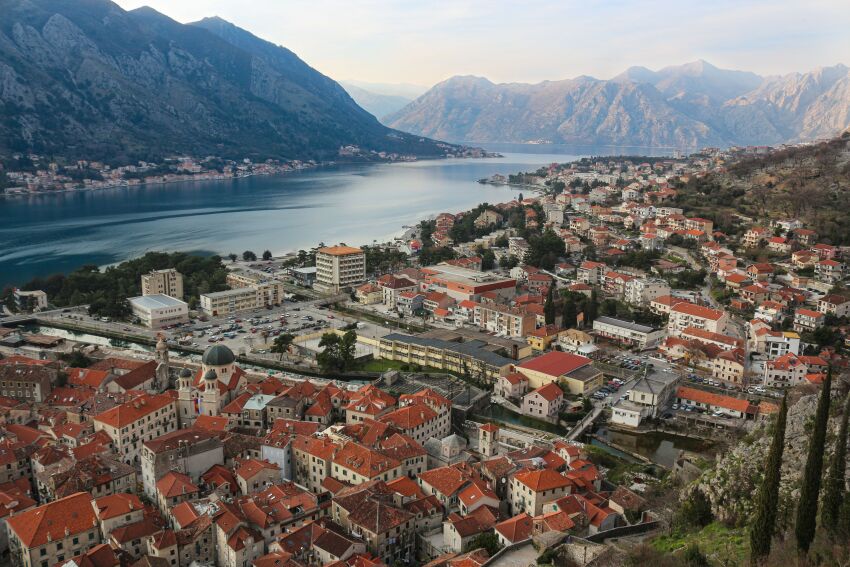
Just 5 kilometers from Tivat and its airport and 22 kilometers from the trendy Budva — here lies the city of Kotor. This picturesque port town is arguably one of the most beautiful places in Montenegro. It’s a lovely spot for vacation in the summer and a comfortable place to live in the winter. Kotor is perfect for those who love ancient architecture and narrow streets, but also for those who prefer a slow-paced life, savoring every moment.
Infrastructure
Kotor’s infrastructure isn't highly developed — it strives to maintain its ancient charm, which gives the city a unique character. However, it has everything needed for daily life: shops, cafes, a bus station with routes to other locations, even a university branch and a college. Along the coast, there are shuttle taxis.
Special Features
Kotor has a special atmosphere, which is why it's protected by UNESCO. The old town is filled with historic mansions, palaces and Romanesque churches. The fortress walls around the town are considered one of the best examples of medieval fortification art.
The best part about Kotor is the seamless blend of old and new. They complement each other perfectly, creating a unique vibe you won't find in other Montenegrin towns.
Advantages
- Thanks to its location, Kotor doesn't get unbearably hot in the summer, and its winters are as mild as in Budva and Herceg Novi.
- The town and its surroundings are packed with attractions, including a picturesque bay and a wonderful waterfront.
- There's almost no crime — the safety index here is even higher than the national average.
Disadvantages
- Unfortunately, Kotor's reputation as the "Pearl of Montenegro" has driven up local prices. Renting a place is quite expensive, especially in the historic center. Additionally, prices for groceries and other items are sky-high, influenced by cruise tourism — tourists from cruise ships spend freely, and sellers hike up the prices.
- Due to very high humidity, houses can be damp, and there’s no central heating in the winter — be prepared for this, especially since winters in Kotor are cooler than in Budva.
- The internet speed isn’t very fast — around 60 Mbps, and unlimited plans cost about 25 euros.
- During the summer, parking is scarce — car owners should be aware that even paid parking spots can be hard to find in peak season.
- In the summer, traffic jams at the town’s entrances and exits are common because of the buses taking tourists from cruise ships on excursions.
6. Herceg Novi
It is also called the “City of a Thousand Stairs”.
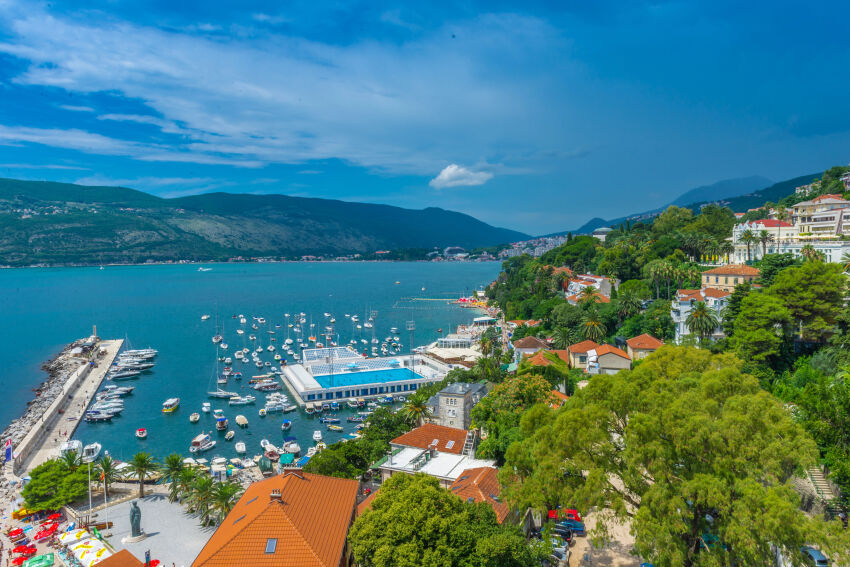
Near the Croatian border lies the small town of Herceg Novi. It's full of stairs that are cascading down the hillside like a waterfall to the sea.
Herceg Novi is a resort town: cozy, quiet and peaceful in the winter, but flooded with beach-seeking travelers in the summer. Many expats have chosen Herceg Novi as their permanent home — it’s convenient, has everything needed for daily life and is full of interesting sights. The only downside is the hustle and noise from tourists in the summer.
Well, that's not the only downside. Herceg Novi isn't very suitable for young parents — it’s tough to navigate the endless, often steep stairs with a stroller.
Infrastructure
There are no concrete high-rises, but everything a city dweller needs is here: shops, pharmacies, cafes, hospitals, and supermarkets. There’s no train station or airport, but there is a bus station with routes to other parts of Montenegro, including Dubrovnik, which has an airport.
Herceg Novi is situated between the towns of Zelenika and Igalo, famous for its health spas. You can reach Igalo directly via the waterfront.
Special Features
Living in Herceg Novi in the winter is pleasant. It rarely rains, December and January are warm, and by February, the mimosa trees are already blooming.
The locals are mainly Serbs, offering a different cultural experience. The border location also provides more travel opportunities.
Advantages
- Compared to most other resort towns, Herceg Novi offers relatively affordable prices, including for rental properties.
- With an abundance of greenery, including ancient trees, it’s known as the "botanical garden of the country."
- The air is excellent, and the climate is fantastic due to the proximity of the mountains and the sea.
- Another advantage is safety — the crime rate here is lower than the national average.
Disadvantages
The downsides of Herceg Novi are typical for most coastal towns, including:
- Dampness,
- A lack of cultural activities in the winter and off-season,
- High communication costs,
- No central heating.
A local peculiarity is the stair-stepped streets, which are inconvenient for daily movement.
The healthcare system could be better. To see a specialist, you need a referral from a clinic or you have to go to a private clinic.
7. Cetinje
The cultural and historical capital of the country, the spiritual center of the state.
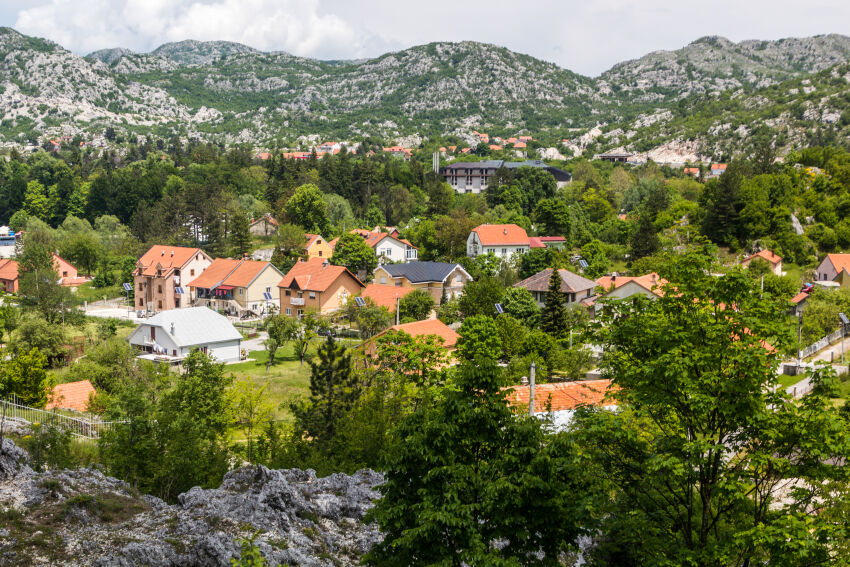
The picturesque and atmospheric Cetinje is located at the foot of the Lovcen mountain range, sitting 671 meters above sea level. Cetinje is small, with just 15,000 residents and an area of about 6 square kilometers.
This compact area is packed with dozens of attractions: churches, palaces and monuments. Because of this, Cetinje is often called a museum city, where you can learn about the country's history just by wandering its cozy, narrow streets. In fact, this small town boasts seven museums, each with unique exhibits.
The climate here is moderately continental, unlike the coastal towns. Cetinje is perfect for those who dislike summer heat and don’t mind cool winters. Plus, both the sea and the bustling city of Podgorica are just an hour's drive away.
The most important thing is that life here is calm and unhurried. During the summer months, there are few tourists, and in winter, most visitors head to the ski resorts.
Infrastructure
Cetinje has everything needed for daily life: a state hospital, restaurants and shops, two large parks, schools, and kindergartens. It also hosts a branch of the University of Montenegro, specializing in dramatic arts.
Special Features
As the cultural capital, Cetinje is located near the Lovćen National Park, so winters can bring snow and temperatures down to -4°C. The town is unlike any other in the country and resembles an unpretentious European countryside.
Advantages
Cetinje is appealing not only for its serene and spiritual lifestyle and excellent environment but also for its practical benefits:
- Living here is cheaper than on the coast — one person needs about 585 euros per month for food, utilities, and entertainment.
- The town frequently hosts various festivals and cultural events.
- Summer temperatures are comfortable, not exceeding 25°C.
- There aren’t many cars, so there are no traffic jams or overcrowded parking lots.
Disadvantages
There are some downsides:
- Cetinje is considered one of the rainiest cities in Europe, with up to 8 days of rain per month.
- Winters can be smoky because locals use wood stoves for heating.
- There are few job opportunities in Cetinje. Many residents commute to the capital, Podgorica, 40 kilometers away.
- Newcomers might find it boring; the cultural life revolves mainly around local traditions and national holidays.
8. Sutomore
Small and cozy, it is considered the most inexpensive town on the coast.
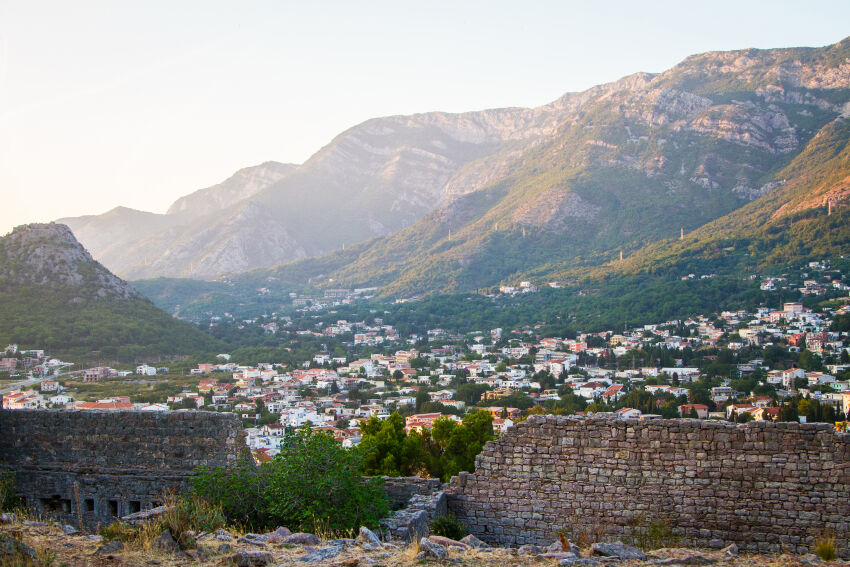
Another resort town in Montenegro is Sutomore, located in the Bar municipality. We have chosen it as one of the best places for permanent residence. It doesn't get too crowded with tourists except during peak season, so living in Sutomore in the winter is peaceful and comfortable. For those who prefer quiet, dislike hustle and bustle, and don't mind a provincial setting, Sutomore is ideal for year-round relocation. However, during the hot season, things change — Sutomore is very popular with Serbs who come with their families to spend weekends or just to swim. Be prepared for the summer influx of tourists if you’re considering moving to this city.
Infrastructure
Sutomore is small but has a well-developed transportation network. You can reach any other town in the country by train or bus.
Special Features
Sutomore is surrounded by hills and pine forests, making the environment excellent, with wonderful air quality. The air is filled with the scents of herbs and flowers year-round, untainted by industrial pollution since there are no industrial plants for many kilometers around.
Advantages
- Sutomore has a large sandy beach, which is quite rare in the country. It’s a great choice for families with children.
- The town has an ideal transportation hub — easy access to any other place in the country.
- Prices here are low — renting property is cheaper than in any other town on the Adriatic coast.
- Sutomore has everything needed for a comfortable life — supermarkets, cafes, a school, a clinic, a post office, and other amenities. There are also both private and public kindergartens.
Disadvantages
Some of the downsides of Sutomore include:
- Strong stormy winds in the cold season.
- Lack of cultural life.
- No banks and only one ATM available.
- Unemployment.
Finding a job in the town is almost impossible, so you'll either need to consider remote work or find employment elsewhere.
9. Niksic
The most industrial city of Montenegro.
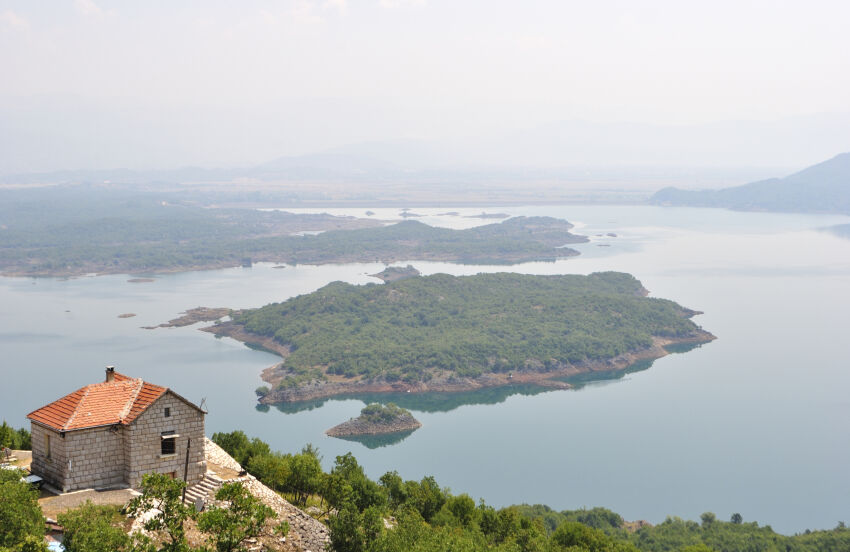
Niksic is the second-largest town in Montenegro after Podgorica, located in the center of the country, just 53 kilometers away from the capital. It has over 55,000 residents, which is significant for a country with a population of only 600,000.
Niksic hosts numerous companies, large industrial enterprises, factories, the Trebjesa brewery, and a bauxite mine. It is suitable for those who don't want to give up a fast pace and high standard of living, even if it means living in an area that isn't very environmentally friendly.
Infrastructure
Niksic boasts excellent infrastructure, including transportation. It's the only town in the country (besides Podgorica) with a bypass road, so transit traffic avoids the center. The town has bus and train stations, and a highway connects it to other towns as well as Herzegovina and Bosnia. So, getting around is not a problem.
Regarding other infrastructure, Niksic won't disappoint: there are many supermarkets, 25 primary schools and 4 secondary schools, shops, 11 kindergartens, hospitals, cafes and restaurants, a branch of the University of Montenegro, several museums, a theater, and even a local TV channel. Nicsik has a vibrant cultural life, with frequent festivals, exhibitions, and theater and cinema evenings.
Special Features
Niksic is very different from what a traveler might expect in Montenegro. It is lively, without a seaside, and offers job opportunities.
At the same time, the spirit of the country is preserved here: the town and its surroundings are rich with historic landmarks, including an ancient fortress, a mosque, and the Cathedral of St. Basil of Ostrog — the most revered saint in Montenegro.
Advantages
- Niksic is a large town with well-developed infrastructure and good transportation links.
- It is surrounded by mountains and forests, with picturesque artificial lakes.
- Prices are affordable, and the quality of life is higher than on the coast.
- There are job opportunities, and they are not seasonal: Niksic is developing as both an industrial and business center.
Disadvantages
Some downsides of Niksic include:
- A high pace of life.
- Less-than-ideal environmental conditions.
- Distance from the sea.
However, in such a compact country, nothing is really far away.
10. Zabljak
The ski center of the country.
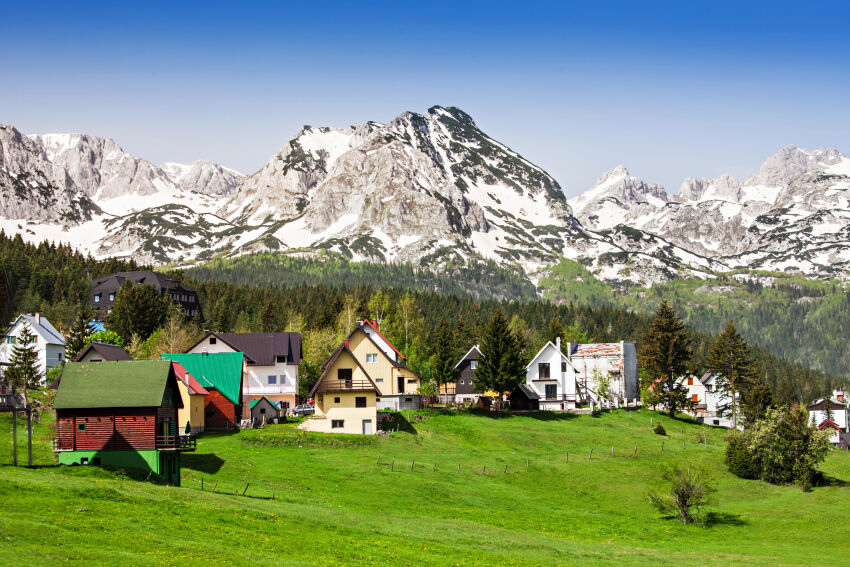
Zabljak is a tiny village even by local standards, located in the north of the country, right in the heart of the mountains at an elevation of 1,450 meters above sea level. It has a population of about 2,000 people, but this number increases significantly in the winter.
This peaceful village is perfect for those looking for a picturesque and very secluded place to enjoy tranquility and serenity. Imagine: it's just you, the forest, and the mountains around you.
Infrastructure
Zabljak has limited infrastructure and only one main street. There is a bus station, some shops and restaurants, a gas station and, of course, some hotels.
Special Features
Since Zabljak is high in the mountains, it's important to consider this if you plan to move here — the air is quite thin. The area has an alpine climate with cold winters and cool, comfortable summers — it's much easier to breathe here than on the coast. However, it often rains — expect around 5-10 rainy days each month.
Advantages
The surroundings of Zabljak are breathtakingly beautiful. There are glacial lakes, majestic forests and mountain peaks that are covered in snow during the winter. In winter, Zabljak becomes lively with people coming to ski.
Living in Zabljak is inexpensive — rent is lower than in other settlements.
Disadvantages
Even this idyllic spot has its downsides. Zabljak is not suitable for those who dislike the cold and are used to having metro and shops within walking distance:
- Winters are quite cold — the temperature can drop to -8°C, sometimes even to -20°C, and snow can accumulate up to half a meter.
- The remoteness from modern conveniences also has an impact — living a secluded lifestyle isn’t for everyone.
- Job opportunities in Zabljak are scarce — 90% of locals earn a living by renting out accommodations to tourists.
- Mobile phone service is expensive throughout the country, and the internet is slow.
- While there is a clinic, the nearest hospital is 20 kilometers away in Šavnik.
11. Petrovac
A small and cozy city, but a popular tourist resort.
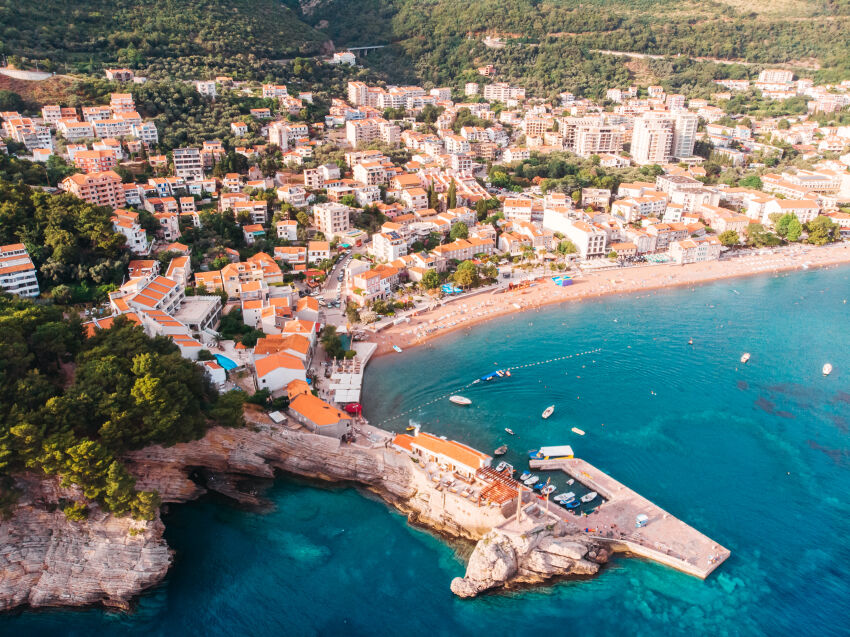
Petrovac is quite suitable for long-term living, especially for die-hard introverts. It's not too noisy, even during the high season, and it's small and cozy. In winter, life here comes to a halt: cafes and restaurants close, and there are hardly any people around. However, supermarkets are open year-round and there is a school, a post office, a kindergarten and ATMs for paying utility bills. It's a convenient place for families with children who don't enjoy noisy entertainment.
Infrastructure
The resort has well-developed infrastructure, including a bus station, post office, medical center, clinics, pharmacies, supermarkets, shops, markets, a school and a kindergarten. There are many fish restaurants and even a stadium. One of the local attractions is a large picturesque park with pine trees by the sea.
Special Features
Petrovac is located 17 kilometers from Budva and is surrounded by olive and pine trees. It also has one of the most beautiful beaches on the Adriatic.
Advantages
Petrovac is quieter and more peaceful than Budva. Additionally:
- All necessary infrastructure is within walking distance.
- The beaches, with their gentle slope into the water, are ideal for children.
Disadvantages
- Job opportunities are limited.
- In winter, Petrovac is hit by storms, and homes can be damp and chilly due to the lack of central heating.
12. Ulcinj
The southernmost resort in the country.
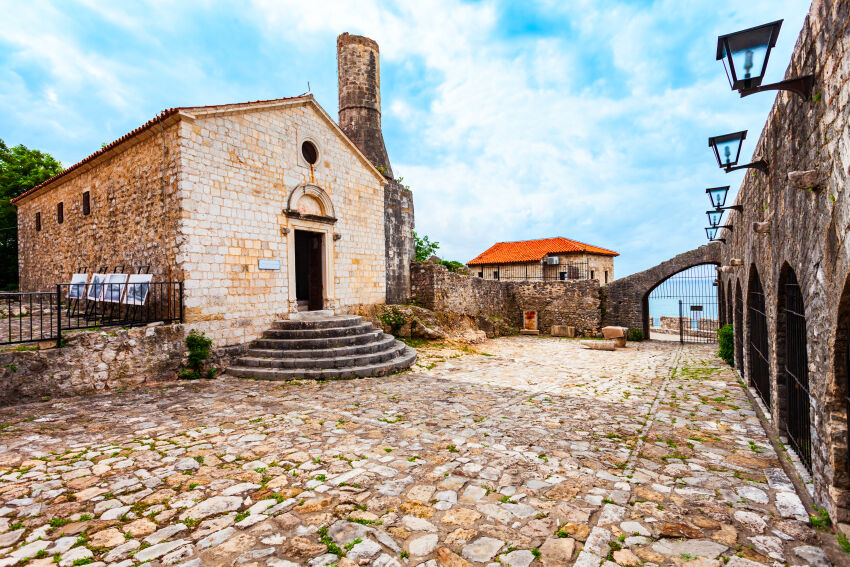
Ulcinj is located on the border with Albania, being about an hour and a half drive from the capital and Tivat Airport.
Infrastructure
Ulcinj has everything that is necessary for a long-term living: supermarkets, post office, pharmacies, clinics, schools and kindergartens, cafes, and restaurants. The roads are good, and there are no traffic issues. In the neighborhood of this ancient town, there are several attractions for those interested in ancient history. Nearby, you'll find the picturesque Lake Šas.
Special Features
The summer here lasts a couple of weeks longer than on the rest of the coast, and it's constantly windy, which attracts surfers. Ulcinj also boasts some of the most luxurious and spacious beaches in Montenegro. The 18-kilometer-long sandy beach with a gentle slope into the sea is perfect for families with children.
The town is small, adorned with greenery and flowers, and is very beautiful, with ongoing beautification efforts. Since Ulcinj is on the border, the majority of its residents are Albanian. Alongside Orthodox Christianity, Islam is widely practiced, and there are mosques. Schools teach in both Albanian and Montenegrin. The Montenegrin language is not very common here; people mostly communicate in Albanian and sometimes in English. You'll need to get used to the eastern atmosphere and Muslim traditions.
Most newcomers are Europeans or former residents of Albania and Kosovo. Ulcinj is ideal for those who want to live in a well-maintained seaside town but prefer to avoid a large number of compatriots and enjoy an eastern vibe.
Advantages
Ulcinj is a calm and relatively quiet town, with no active nightlife outside of the tourist season. Additionally:
- Its proximity to the borders with Albania, Greece, and Macedonia offers great travel opportunities.
- Property prices are lower than in most coastal locations in the country.
- Ulcinj has a very high safety index.
Disadvantages
There are some downsides:
- There is almost no public transport, so you'll need to walk, rent or buy a car.
- While rental prices are low, they double or triple during the tourist season.
- Local mobile phone services are very expensive.
- The strong Muslim influence and Eastern mentality might make it challenging to integrate if you are not initially comfortable with these cultural aspects. But if you are — then it could be an advantage.
The Cities of Montenegro on the map
To help you evaluate the locations more conveniently, we have created a map of the best places to live in Montenegro for relocation.
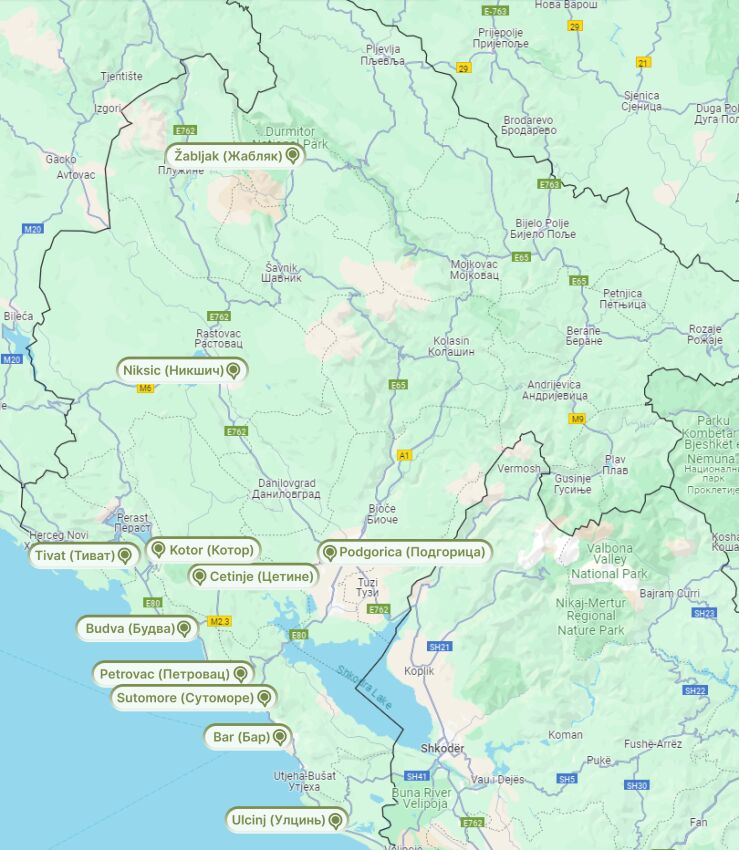
In Conclusion
Montenegro is a small but rapidly developing country, with growth not just in tourism, but in other areas as well. This country is great for both vacation and permanent living. Despite its tiny size by global standards, there’s a suitable spot for travelers with a wide range of preferences and requirements.
Not ready to give up the comforts and familiar conditions of big city life? Head to Podgorica or Budva. If you want to spend your days and months away from the hustle and bustle, surrounded by beautiful landscapes and enjoying seaside walks, there are plenty of cozy little towns along the coast. Do you prefer minimal social interaction and can’t stand the heat? Then you should check out the conditions in Zabljak. Under the bright blue sky of this country, you’ll find a place that suits you in this unique, cozy, and welcoming country.

